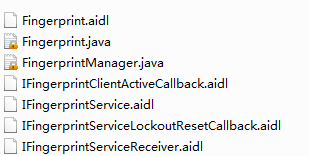Android P 指纹 Framework
从Android的官方API可以查到,向上层提供接口的是FingerprintManager,它的代码在路径frameworks/base/core/java/android/hardware/fingerprint下。
/**
* A class that coordinates access to the fingerprint hardware.
* @deprecated See {@link BiometricPrompt} which shows a system-provided dialog upon starting
* authentication. In a world where devices may have different types of biometric authentication,
* it's much more realistic to have a system-provided authentication dialog since the method may
* vary by vendor/device.
*/
@Deprecated
@SystemService(Context.FINGERPRINT_SERVICE)
@RequiresFeature(PackageManager.FEATURE_FINGERPRINT)
public class FingerprintManager implements BiometricFingerprintConstantsframeworks/base/core/java/android/hardware/fingerprint目录下内容其实很少,一共只有几个文件。
这里除了FingerprintManager之外,就只有Fingerprint一个类了,其他都是aidl文件。
粗略的看了下Fingerprint类,它里面的内容超级少,主要是包含了几个成员变量,用来记录指纹的信息。
/**
* Container for fingerprint metadata.
* @hide
*/
public final class Fingerprint extends BiometricAuthenticator.BiometricIdentifier {
private CharSequence mName;
private int mGroupId;
private int mFingerId;
private long mDeviceId; // physical device this is associated with
public Fingerprint(CharSequence name, int groupId, int fingerId, long deviceId) {
mName = name;
mGroupId = groupId;
mFingerId = fingerId;
mDeviceId = deviceId;
}
//...
}如果仔细看代码的话,可以发现一个很神奇的东西,那个就Fingerprint类的所有成员都是private的,并且没有提供任何public的set方法!
这个就厉害了,因为有做过指纹部分的朋友一定记得指纹提供一个rename的接口。没有public的set方法,那它又是怎么实现rename接口的呢?
带着问题看源码!
rename方法在Manager中的实现如下:
/**
* Renames the given fingerprint template
* @param fpId the fingerprint id
* @param userId the user who this fingerprint belongs to
* @param newName the new name
*
* @hide
*/
@RequiresPermission(MANAGE_FINGERPRINT)
public void rename(int fpId, int userId, String newName) {
// Renames the given fpId
if (mService != null) {
try {
mService.rename(fpId, userId, newName);
} catch (RemoteException e) {
throw e.rethrowFromSystemServer();
}
} else {
Slog.w(TAG, "rename(): Service not connected!");
}
}这里先直接找到Manager的服务类:FingerprintService
指纹服务的相关代码在frameworks\base\services\core\java\com\android\server\fingerprint下。
/**
* A service to manage multiple clients that want to access the fingerprint HAL API.
* The service is responsible for maintaining a list of clients and dispatching all
* fingerprint-related events.
*
* @hide
*/
public class FingerprintService extends SystemService implements IHwBinder.DeathRecipient看一下它里面的rename是在内部类FingerprintServiceWrapper中实现的,具体如下:
@Override // Binder call
public void rename(final int fingerId, final int groupId, final String name) {
checkPermission(MANAGE_FINGERPRINT);
if (!isCurrentUserOrProfile(groupId)) {
return;
}
mHandler.post(new Runnable() {
@Override
public void run() {
mFingerprintUtils.renameFingerprintForUser(mContext, fingerId,
groupId, name);
}
}
}找到同文件夹下FingerprintUtils类,这个是工具类,里面维护了一组FingerprintsUserState,具体得继续看FingerprintsUserState;
FingerprintsUserState中维护了一组Fingerprint,下面具体看下rename操作:
@GuardedBy("this")
private final ArrayList mFingerprints = new ArrayList();
//...
public void renameFingerprint(int fingerId, CharSequence name) {
synchronized (this) {
for (int i = 0; i < mFingerprints.size(); i++) {
if (mFingerprints.get(i).getFingerId() == fingerId) {
Fingerprint old = mFingerprints.get(i);
mFingerprints.set(i, new Fingerprint(name, old.getGroupId(),
old.getFingerId(), old.getDeviceId()));
scheduleWriteStateLocked();
break;
}
}
}
} 这里可以看到,在rename的实现时,代码直接霸气的new一个Fingerprint对象,然后覆盖List中对应id的对象。
OK,以上只是一个小小的流程。
下面看下FingerprintManager的主要API:
public void enroll(byte [] token, CancellationSignal cancel, int flags,
int userId, EnrollmentCallback callback);
public void remove(Fingerprint fp, int userId, RemovalCallback callback);
public void rename(int fpId, int userId, String newName);
public List getEnrolledFingerprints();
//不是hide的方法
public void authenticate(@Nullable CryptoObject crypto, @Nullable CancellationSignal cancel,int flags, @NonNull AuthenticationCallback callback, @Nullable Handler handler);
public boolean hasEnrolledFingerprints();
public boolean isHardwareDetected() 真正对三方开放的API只有最下面的三个,分别用来授权、判断是否录入过指纹、判断设备是否支持指纹器件。
这里面要特别提一下authenicate方法;
/**
* Request authentication of a crypto object. This call warms up the fingerprint hardware
* and starts scanning for a fingerprint. It terminates when
* {@link AuthenticationCallback#onAuthenticationError(int, CharSequence)} or
* {@link AuthenticationCallback#onAuthenticationSucceeded(AuthenticationResult)} is called, at
* which point the object is no longer valid. The operation can be canceled by using the
* provided cancel object.
*
* @param crypto object associated with the call or null if none required.
* @param cancel an object that can be used to cancel authentication
* @param flags optional flags; should be 0
* @param callback an object to receive authentication events
* @param handler an optional handler to handle callback events
*
* @throws IllegalArgumentException if the crypto operation is not supported or is not backed
* by Android Keystore
* facility.
* @throws IllegalStateException if the crypto primitive is not initialized.
* @deprecated See {@link BiometricPrompt#authenticate(CancellationSignal, Executor,
* BiometricPrompt.AuthenticationCallback)} and {@link BiometricPrompt#authenticate(
* BiometricPrompt.CryptoObject, CancellationSignal, Executor,
* BiometricPrompt.AuthenticationCallback)}
*/
@Deprecated
@RequiresPermission(anyOf = {USE_BIOMETRIC, USE_FINGERPRINT})
public void authenticate(@Nullable CryptoObject crypto, @Nullable CancellationSignal cancel,
int flags, @NonNull AuthenticationCallback callback, @Nullable Handler handler) {
authenticate(crypto, cancel, flags, callback, handler, mContext.getUserId());
}其中flags暂时没用起来,直接设置为0。
这里稍微讲下crypto objiect。它是的一个内部类。暂时支持三种类型对象。如下:
/**
* A wrapper class for the crypto objects supported by FingerprintManager. Currently the
* framework supports {@link Signature}, {@link Cipher} and {@link Mac} objects.
* @deprecated See {@link android.hardware.biometrics.BiometricPrompt.CryptoObject}
*/这个参数用于加密,保护指纹在使用过程中不被恶意软件截获和篡改。
Google的示例中用的是Cipher的加密对象。
需要结束监听的话,使用CancellationSignal对象的cancel方法即可。
上面提到过Manager里面的API具体实现都是Service中。
Manager中保存有Service的对象private IFingerprintService mService;
这对象看命名方式就可以大概猜到是个AIDL了;
/**
* Communication channel from client to the fingerprint service.
* @hide
*/
interface IFingerprintService它是在Manager的构造函数作为参数传入的,找到创建Manager的地方:
frameworks/base/core/java/android/app/SystemServiceRegistry.java
registerService(Context.FINGERPRINT_SERVICE, FingerprintManager.class,
new CachedServiceFetcher() {
@Override
public FingerprintManager createService(ContextImpl ctx) throws ServiceNotFoundException {
final IBinder binder;
if (ctx.getApplicationInfo().targetSdkVersion >= Build.VERSION_CODES.O) {
binder = ServiceManager.getServiceOrThrow(Context.FINGERPRINT_SERVICE);
} else {
binder = ServiceManager.getService(Context.FINGERPRINT_SERVICE);
}
IFingerprintService service = IFingerprintService.Stub.asInterface(binder);
return new FingerprintManager(ctx.getOuterContext(), service);
}}); 从这里看,关键字是Context.FINGERPRINT_SERVICE这个服务!
这时候,灵机一动看一眼FingerprintService(通过搜索可以搜到FingerprintService),它的onStart方法中有发布这个服务,发布的是它的内部类FingerprintServiceWrapper,这里就解释了为什么之前Manager里面的rename方法最后会在FingerprintServiceWrapper被搜索到。
@Override
public void onStart() {
publishBinderService(Context.FINGERPRINT_SERVICE, new FingerprintServiceWrapper());
SystemServerInitThreadPool.get().submit(this::getFingerprintDaemon, TAG + ".onStart");
listenForUserSwitches();
}而FingerprintService本身是在frameworks/base/services/java/com/android/server/SystemServer.java中启动的;
if (mPackageManager.hasSystemFeature(PackageManager.FEATURE_FINGERPRINT)) {
traceBeginAndSlog("StartFingerprintSensor");
mSystemServiceManager.startService(FingerprintService.class);
traceEnd();
}
下面来看一下一个消息反馈的AIDL:IFingerprintServiceReceiver;
/**
* Communication channel from the FingerprintService back to FingerprintManager.
* @hide
*/
oneway interface IFingerprintServiceReceiver {
void onEnrollResult(long deviceId, int fingerId, int groupId, int remaining);
void onAcquired(long deviceId, int acquiredInfo, int vendorCode);
void onAuthenticationSucceeded(long deviceId, in Fingerprint fp, int userId);
void onAuthenticationFailed(long deviceId);
void onError(long deviceId, int error, int vendorCode);
void onRemoved(long deviceId, int fingerId, int groupId, int remaining);
void onEnumerated(long deviceId, int fingerId, int groupId, int remaining);
}它的实例在Manager中;
private IFingerprintServiceReceiver mServiceReceiver = new IFingerprintServiceReceiver.Stub作为参数被传递给Service,实现消息反馈机制。
如果仔细看下FingerprintService所在的文件夹,除了之前提到过的FingerprintService、FingerprintUtils和FingerprintsUserState以外就只剩下大量和ClientMonitor 相关的类了;
/**
* Abstract base class for keeping track and dispatching events from fingerprint HAL to the
* the current client. Subclasses are responsible for coordinating the interaction with
* fingerprint HAL for the specific action (e.g. authenticate, enroll, enumerate, etc.).
*/
public abstract class ClientMonitor implements IBinder.DeathRecipient它的子类包括AuthenticationClient、EnrollClient、EnumerateClient、InternalEnumerateClient、InternalRemovalClient和RemovalClient。
它们是真正负责和更下层的HAL层交互的类。
HAL层有关的内容这里暂不讨论。
这样的话,大概的一组流程被整理出来,FingerprintManager内部持有FingerprintService内部类FingerprintServiceWrapper的AIDL,FingerprintManager的API都是调用FingerprintServiceWrapper提供的接口实现的,同时通过参数实现IFingerprintServiceReceiver消息回传。
这里还有一点可以提一下,那就是指纹授权时的震动;
- frameworks/base/services/core/java/com/android/server/fingerprint/AuthenticationClient.java中会在授权成功或失败后调用vibrateSuccess()和vibrateError()方法实现不同的震动效果
- frameworks/base/services/core/java/com/android/server/fingerprint/ClientMonitor.java有vibrateSuccess()和vibrateError()两个方法的具体实现
- 在ClientMonitor中可以看到frameworks\base\core\java\android\os\VibrationEffect.java是真正实现震动的类
- 可以通过用VibrationEffect的createOneShot或createWaveform方法创建想要的震动效果

